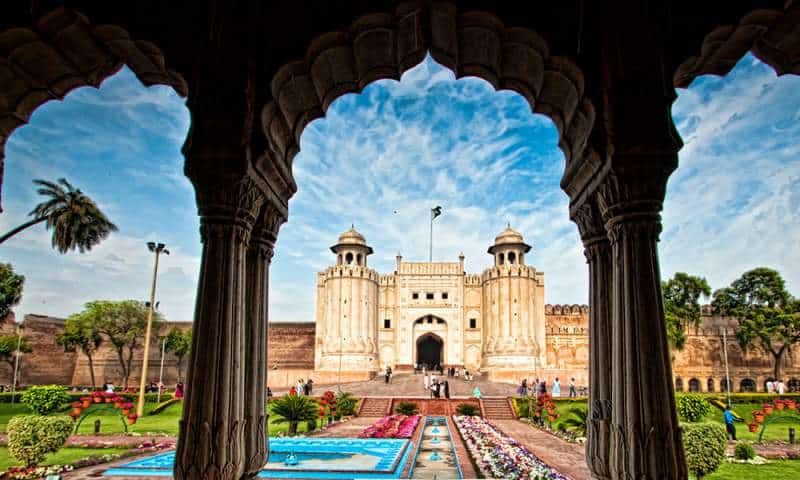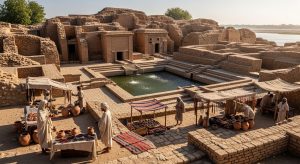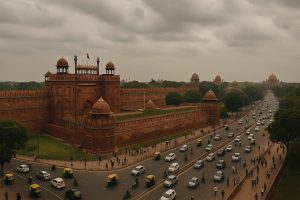Once Lahore was known for its gardens, Bagh Gul Begum, Bagh e Zaibun Nisa, an almond garden called Badami Bagh right across the Lahore Fort. Mirza Kamran’s pavilion, Bagh e Dilkusha on the West bank of River Ravi, also called Shah Dara, and then Bagh Wazir Khan, Bagh e Anarkali, Gulshan e Ravi and the Chauburji Gardens also known as Bagh E Zaib un Nisaall situated on the Southern bank of the river. Bagh E Dilkusha became the burial grounds where the Great Mughal Queen Noor Jahan buried her husband the King Jahangir.
The Lawrence Garden which still stands in the midst of the city is a colonial addition, whereas, the famous Shalimar Gardens now considered as a part of the World heritage was done by the Mughal Emperor Shahjahan. In addition, to these there were several small gardens that all contributed to the natural beauty of Lahore city, thereby giving it the title, “City of the Gardens.”
I remember a lot of times when we used to go to the Shalimar Gardens with the family. As kids, we enjoyed running around in the grassy plots filled with nice perennials and fruit trees. Water fountains in the middle were a pleasant divide with a waterfall leading to the second level about twenty feet with a large forty by eighty feet pond right in the middle is a beauty. All built in the red stone from Agra, with a fine touch of white marble minarets.
A special podium built on the craves of the second and the third level. Small arches crafted in white marble stone, to light oil lamps behind created waterfalls emulating spring waters coming down in another pool with a splash creating a natural spring musical, have become a Shalimar’s signature in the Indo Pak Sub- Continent Architecture. With so much beauty around, I still was looking for something that made it exceptionally special, an echo of which was resounding all over the World.
Although I knew there was a piece missing in this Jigsaw puzzle, I could just feel it but wasn’t sure what this missing link was. Just recently came across some breathtaking images of the beautiful Nishat Bagh in Sri Nagar, Kashmir valley and found out that Shalimar Garden of Lahore took its inspiration from it.
I also came across an old miniature of Maharaja Ranjeet Singh sitting on the second terrace at Shalimar Garden Lahore, with River Ravi in the backdrop, and right there and then, I knew that was the missing link I had been looking for.
The third terrace ended on the footsteps of River Ravi, which now has moved about a mile towards the North. Most visitors from abroad and even from the city have forgotten Shalimar’s link to the river, which is or was the key in assessing its beauty, convenience, and elevates its status as a Royal garden in comparison to all others in and around Lahore. That was the missing link; an answer to a lot of questions my mind had been mumbling about and I had been so inquisitive for all those years.
The Royal Mughal garden, called Nishat Bagh Is a beautiful terraced garden on the Eastern side of Dal Lake in Shrinagar, Kashmir Valley, and Shah Jahan is said to be the major contributor of the structures associated with it. Water from mountain springs and waterfalls are drawn across twelve terraces into the Dal Lake.
Tall mountains all around with fruit-laden trees and tulips with the serenity of the lake make it a spectacle. No wonder why, the Mughal emperors preferred to spend their summers in Kashmir and reiterated it as a paradise.
After looking at the floor plans of the Nishat Bagh I started looking for its complementary features in the Shalimar Garden. My quest was to find, if it had the same floor plan, then how they compensated for the beautiful Dal Lake and its waters. Sure enough, digging some more archives brought some more interesting info’s into the limelight. Built on the model of Nishat Bagh, the Shalimar garden had River Ravi as a complimentary replacement of the Dal Lake in Kashmir.
The third level had its feet dipped into the river, while its main entrance was about forty to fifty feet higher than the river on the ground level. The story goes when Ali Marian Khan ….governor of Kandahar asked Shahjahan the King if he could be of any service to His Majesty. The King replied with a nod saying, “Yes! Only if he could bring the Nishat Bagh to Lahore, the city of his in-laws where his wife and kids spend their winters, and he gets stranded for the winter months in Lahore, longing for the garden he has in Kashmir.”After a few weeks, Ali Mardan gave him the good news. He had found the right place to put up a beautiful garden with almost the same plan as Nishat Bagh in Kashmir.
The land selected had a natural depression, a canyon created by the floods over a period of time. It could have its entrance at the street level, with a gradual depression of ten to fifteen feet leading to the second level and then again another lowering of ten to fifteen feet ushering to the third level which then becomes the river bank. It would be an ideal royal retreat. Easily excess able by land and river with a distance of not more than five miles either way from the Lahore Fort. It was a dream comes true for the King and his family.
The plan approved and took almost two years to complete it all. Water was drawn out of the river by creating Shah har (now Suk Nahar), a tributary from the river Ravi, to provide for the garden, and an adjacent grape garden called Angori Bagh. Water was then lifted fifty feet to feed all the fountains, the wall falls and plantations before flowing back to the river, across the three terraces. The fruit-laden trees, the lush bushes of colorful flowers, waterfall, and fountains, and a river flowing right in its footsteps. Shalimar had it all in the winter months that one could ask for.
Figuring out the ideas the planers of that era had, and implemented, took my imagination back to mid-seventeenth century Lahore, the time when most of these planned garden were being laid down.
Lahore became a place of glory and the people of Subcontinent envied it. It was known as a city which could only be compared with itself, unmatchable. A local proverb, “Lahore Lahore A” says it all. With all the said gardens, it must have been a treat to live in a city like that. As said in and around Lahore there were with vast stretches of lush greens in all directions, magnificent garden gateways like Chauburji, colorful and fragrant flowers, orchids, cool and pure air free of any pollution along the banks of river Ravi must have been close to a paradise on earth. I can well imagine, a boat ride going upstream on the River Ravi amidst all the gardens on both sides on my way to the Shalimar.
Starting from the river bank adjacent to the Lahore Fort, with sunset on my back, heading for the Royal barbecue feast, landing right on the footsteps of Shalimar Garden, music and performances waiting for me in the white marble pavilions. Now don’t try to wake me up….need some more sleep to keep dreaming.
The writer is working as an Architect in a private firm and she can be reached at (natasha.nadeem91@gmail.com).














